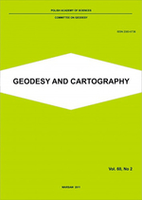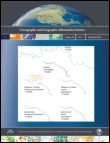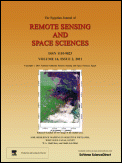
Geodesy and Cartography
Scope & Guideline
Advancing Geospatial Knowledge for a Global Audience
Introduction
Aims and Scopes
- Geodesy and Reference Frames:
Research related to the establishment and adjustment of geodetic reference frames, including studies on transformations between different reference systems. - Spatial Planning and Land Use:
Exploration of methodologies for effective spatial planning and land use management, with a focus on regional development and territorial organization. - Remote Sensing Applications:
Utilization of remote sensing technologies, such as DInSAR and satellite imagery, for monitoring environmental changes and land deformation. - Environmental Monitoring and Management:
Investigation of techniques for assessing environmental parameters, including meteorological observations and soil analysis, to inform land management practices. - Machine Learning in Geodesy:
Application of machine learning techniques to enhance the accuracy of geospatial data analysis, including predictions related to soil properties and terrain modeling. - Foresight and Decision-Making:
Development of decision-making frameworks and foresight methodologies to improve management strategies in various land-use contexts.
Trending and Emerging
- Integration of Remote Sensing and GNSS:
There is a growing emphasis on combining remote sensing technologies with GNSS data for enhanced monitoring of land changes and environmental assessments. - Machine Learning and Data Science Applications:
The use of machine learning for analyzing geospatial data is emerging as a prominent theme, highlighting the journal's focus on innovative analytical techniques. - Regional Development and Territorial Management:
Increased attention to regional land-use planning and management strategies, particularly in the context of socio-economic changes like depopulation. - Interdisciplinary Approaches to Geodesy:
Papers that incorporate insights from various disciplines, such as environmental science and urban planning, are on the rise, showcasing the journal's commitment to interdisciplinary research. - Foresight and Predictive Modeling:
Emerging interest in foresight methodologies for land management decisions indicates a trend towards proactive rather than reactive planning strategies.
Declining or Waning
- Traditional Geodesy Methods:
Research papers focusing solely on classical geodesy methods without integrating modern technology or interdisciplinary approaches have become less common. - Generalized Environmental Studies:
Studies that address broad environmental issues without specific applications to geodesy or cartography have waned, as the journal shifts towards more targeted research. - Outdated Spatial Planning Techniques:
Papers that rely on older spatial planning methodologies, lacking innovative or data-driven approaches, are less frequently seen in recent issues.
Similar Journals

International Journal of Applied Earth Observation and Geoinformation
Navigating the Future of Geoinformation and Sustainability.International Journal of Applied Earth Observation and Geoinformation is a premier peer-reviewed journal published by Elsevier, focusing on the integration and application of earth observation and geoinformation technologies across diverse fields. With an open access model established in 2020, this journal enhances accessibility and dissemination of research crucial for addressing global challenges related to climate change, resource management, and sustainable development. The journal occupies a notable position within the academic community, featuring a Q1 ranking in multiple categories including Computers in Earth Sciences, Earth-Surface Processes, and Global and Planetary Change, reflecting its significant impact and relevance in these disciplines. It is recognized for its high-quality articles that explore innovative methodologies and applications, making it an essential resource for researchers, practitioners, and students alike who seek to advance their understanding of earth dynamics and geospatial technology. The journal is indexed in Scopus with impressive rankings that underscore its high citation impact and scholarly influence, with an emphasis on providing a platform for the latest findings in management, monitoring, and policy in environmental science.

Cartography and Geographic Information Science
Pioneering New Frontiers in Geographic Information SystemsCartography and Geographic Information Science is a premier journal published by Taylor & Francis Inc, focusing on the interdisciplinary realms of geography, planning, and technological innovation. With an impressive impact factor and ranking in the top quartiles across various categories, including Q1 in Geography, Planning and Development and Q2 in Civil and Structural Engineering, this journal serves as an essential resource for researchers, professionals, and students alike, promoting cutting-edge research and advancements in cartography and geographic information systems. The journal disseminates high-quality articles that explore both theoretical and practical aspects of geographic information, aiming to enhance the understanding and application of spatial data. As the field evolves, Cartography and Geographic Information Science remains a vital forum for innovation and scholarly dialogue, offering accessible content to a global audience. With its commitment to rigor and relevance, it plays a critical role in advancing the landscapes of geography and environmental sciences.

Advances in Geodesy and Geoinformation
Advancing Knowledge in Geodesy and GeoinformationAdvances in Geodesy and Geoinformation is a pioneering journal published by the Polish Academy of Sciences, dedicated to the dynamic fields of geodesy and geoinformation. With an ISSN of 2720-7242 and an E-ISSN of 2720-7242, it offers an open-access platform since 2022, making cutting-edge research readily accessible to a global audience. The journal aims to foster the dissemination of innovative methodologies, technologies, and applications in the realms of geospatial data and earth sciences. Researchers, professionals, and students alike can benefit from the high-quality articles that contribute to advancing knowledge in this critical area, bridging theoretical insights and practical solutions. Situated in the heart of Poland, at PL Defilad 1, Warszawa, the journal not only reflects the nation's academic rigor but also positions itself as a crucial hub for international collaboration and knowledge exchange in geodesy and geoinformation.

Egyptian Journal of Remote Sensing and Space Sciences
Leading the Way in Cutting-edge Space Science ResearchThe Egyptian Journal of Remote Sensing and Space Sciences, published by Elsevier, is a premier open-access journal dedicated to advancing the fields of Remote Sensing and Space Sciences. Since its inception, the journal has gained a prominent reputation, currently holding a prestigious Q1 ranking in Earth and Planetary Sciences and placing within the top 10% of its field according to Scopus metrics. With an ISSN of 1110-9823 and an E-ISSN of 2090-2476, the journal features a diverse range of scholarly articles that explore both theoretical and practical aspects of remote sensing technologies and space science innovations, thus appealing to researchers, professionals, and students alike. Established in 2003 and fully transitioning to an open-access model in 2010, the journal aims to disseminate knowledge and foster collaboration across the globe by providing wider accessibility to groundbreaking research findings. Its commitment to quality and innovation is a catalyst for intellectual development in these dynamic and evolving disciplines.

Geo-Spatial Information Science
Exploring the Intersection of Geography and TechnologyGeo-Spatial Information Science, published by TAYLOR & FRANCIS LTD, is a premier open-access journal that has been at the forefront of disseminating cutting-edge research since its inception in 1998. With an ISSN of 1009-5020 and an E-ISSN of 1993-5153, this journal plays a pivotal role in the fields of Computers in Earth Sciences and Geography, Planning and Development, achieving a prestigious Q1 ranking in both categories as of 2023. Its exemplary Scopus rankings highlight its relevance within the social sciences and earth sciences, placing it among the top echelons of its field, with a 95th and 93rd percentile respectively. The journal aims to bridge the gap between innovative geospatial technologies and their applications in real-world scenarios, fostering interdisciplinary collaboration and advancing the global understanding of spatial data analysis. Based in the United Kingdom, Geo-Spatial Information Science invites researchers, professionals, and students to contribute and access research that shapes the future of geo-spatial sciences, all while adhering to open access principles that ensure broad dissemination and engagement with the broader academic community.

Reports on Geodesy and Geoinformatics
Connecting minds through innovative geodesy and geoinformatics insights.Reports on Geodesy and Geoinformatics, an esteemed scholarly journal published by SCIENDO, stands as a vital platform in the field of geodesy, geoinformatics, and related sciences. With an ISSN of 2391-8365 and E-ISSN 2391-8152, this open-access journal has been providing free access to impactful research and advancements in the domain since 2013. Located in Warsaw, Poland, at Bogumila Zuga 32A, Mazovia 01-811, it aims to disseminate high-quality research articles, case studies, and reviews that are crucial for academics, industry professionals, and students alike. The journal's commitment to promoting innovative methodologies and technological advancements reinforces its position as an important resource for fostering collaboration and knowledge sharing across global communities in geodesy and geoinformatics.

Revue Internationale de Geomatique
Advancing the Frontiers of Geomatics ResearchRevue Internationale de Geomatique (ISSN: 1260-5875, E-ISSN: 2116-7060) is a prestigious journal published by TECH SCIENCE PRESS, dedicated to advancing the field of geomatics. This journal serves as a vital platform for disseminating significant research findings, cutting-edge methodologies, and innovative applications within the realm of spatial data and technology. With an emphasis on interdisciplinary studies, it fosters collaboration among researchers, professionals, and students across various domains, including environmental science, urban planning, and geographic information systems (GIS). Although not an open-access journal, Revue Internationale de Geomatique maintains a rigorous peer-review process ensuring the publication of high-quality articles that contribute to the evolving landscape of geomatics. Given its relevance and commitment to scholarly excellence, this journal is a crucial resource for advancing knowledge and practices in the ever-growing field of spatial information science.

International Journal of Engineering and Geosciences
Fostering collaboration in engineering and environmental science.The International Journal of Engineering and Geosciences, with ISSN 2548-0960, is a premier academic journal published by Selcuk University Press, specializing in the interrelated fields of engineering and geosciences. Established as an Open Access resource in 2016, the journal aims to enhance the dissemination of research, fostering collaboration and innovation within the scientific community. Based in Turkey, this journal serves as a vital platform for researchers and professionals to share their findings and contribute to the advancement of knowledge in environmental science and related disciplines. With an impressive Q2 category ranking in the field of Environmental Science (miscellaneous) for 2023, it ranks #81 out of 219 in Scopus, placing it in the 63rd percentile. The journal not only acknowledges transformative research trends from 2019 to 2024 but also emphasizes the importance of sustainability and environmental stewardship in engineering practices, making it an indispensable resource for students, researchers, and professionals passionate about the intersection of these disciplines.

EARTH is a prestigious journal published by MDPI, located in Switzerland, with a commitment to advancing the fields of Earth and Planetary Sciences and Environmental Science. Launched in 2020, the journal emphasizes an open-access publication model, ensuring that high-quality research is widely accessible to the scientific community and beyond. As of 2023, it proudly holds a Q2 ranking in both the Environmental Science and Earth and Planetary Sciences categories, indicating its significant impact within these disciplines; it ranks #90 out of 219 and #70 out of 159 in their respective fields according to Scopus. With the convergence of multidisciplinary research and the critical challenges our planet faces, EARTH seeks to publish innovative studies that foster a deeper understanding of geological and environmental processes. Researchers, professionals, and students alike will find this journal an invaluable resource for the latest findings and discussions shaping our understanding of Earth sciences.

South African Journal of Geomatics
Innovating Mapping Technologies for Global ImpactSouth African Journal of Geomatics is a pivotal platform dedicated to the advancement of geomatics, focusing on the dynamic intersection of geographic information science, surveying, and mapping technologies. Published by CONSAS CONFERENCE, the journal serves as a crucial resource for researchers, professionals, and students in the geomatics field, providing insightful, peer-reviewed articles that explore contemporary challenges and innovations. Operating under an open-access model, the journal ensures the wide dissemination of knowledge, promoting collaboration and scholarly exchange among the global geomatics community. With a commitment to enhancing the visibility of significant research and fostering academic discourse, the South African Journal of Geomatics plays a vital role in contributing to the development of this essential discipline in South Africa and beyond.